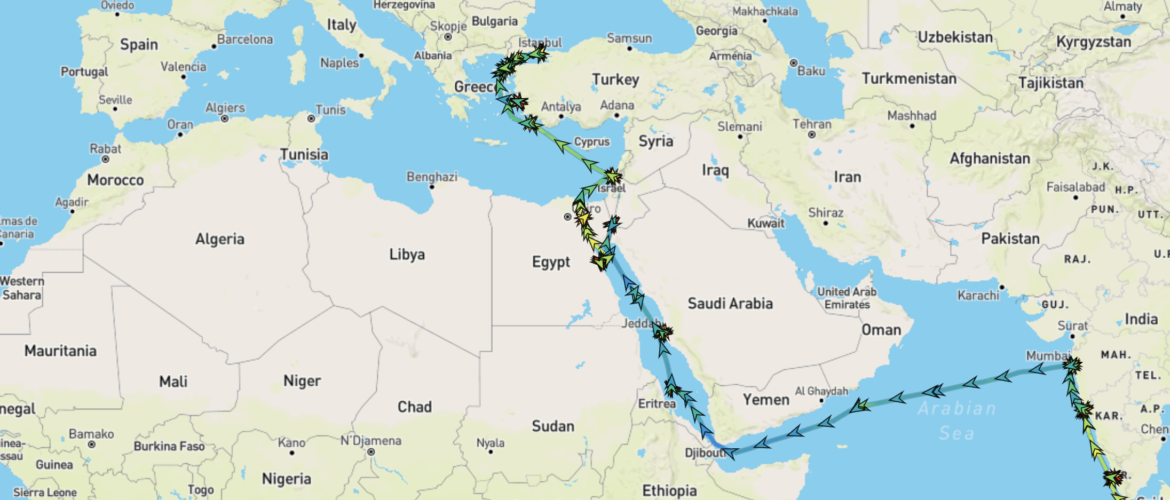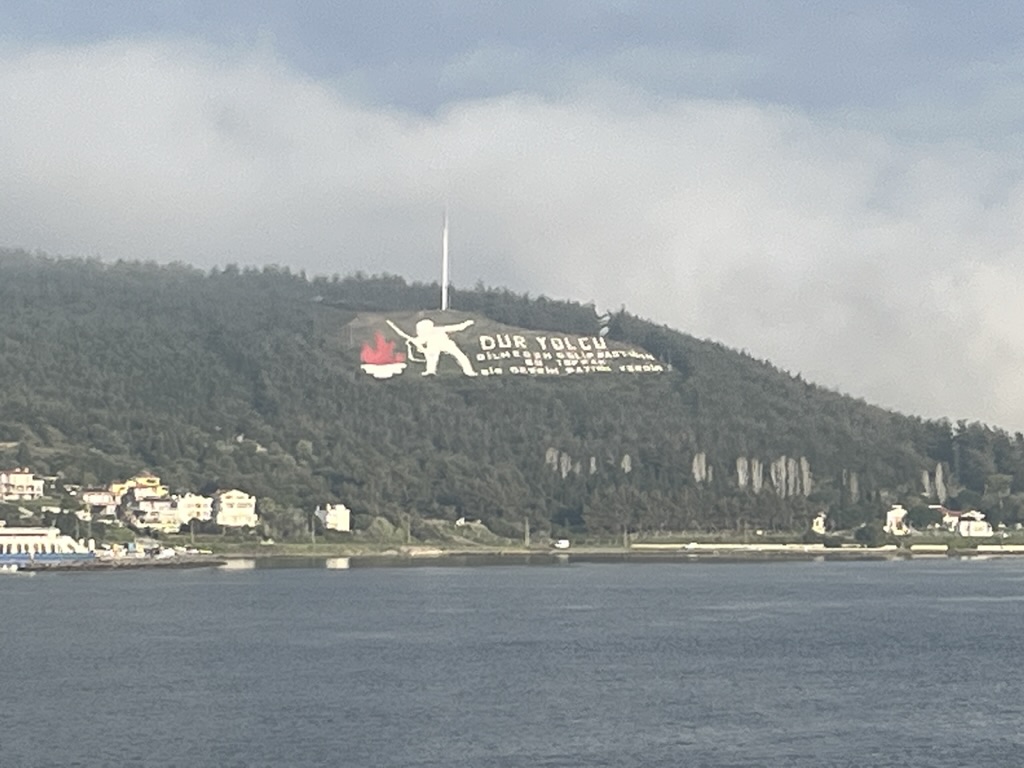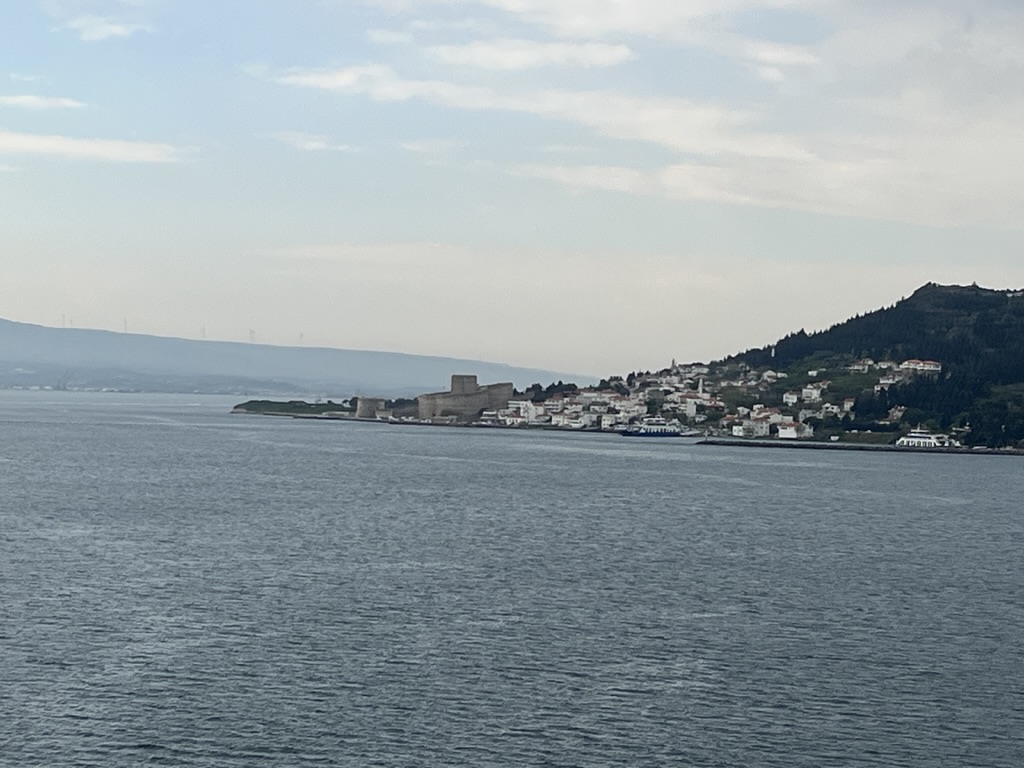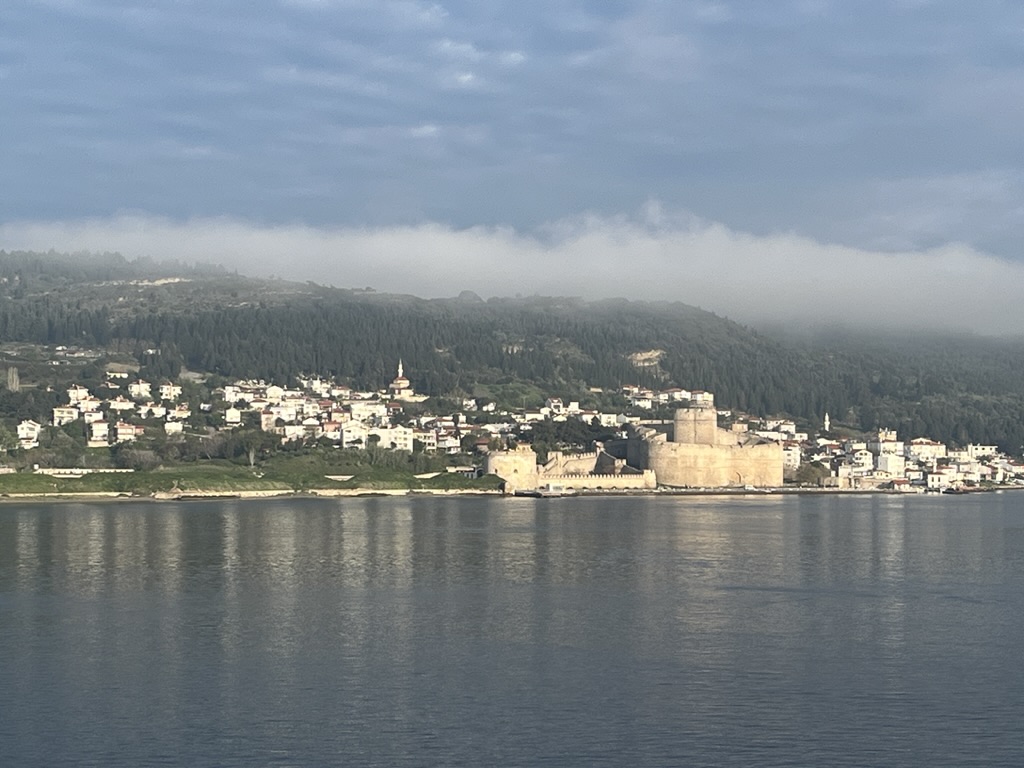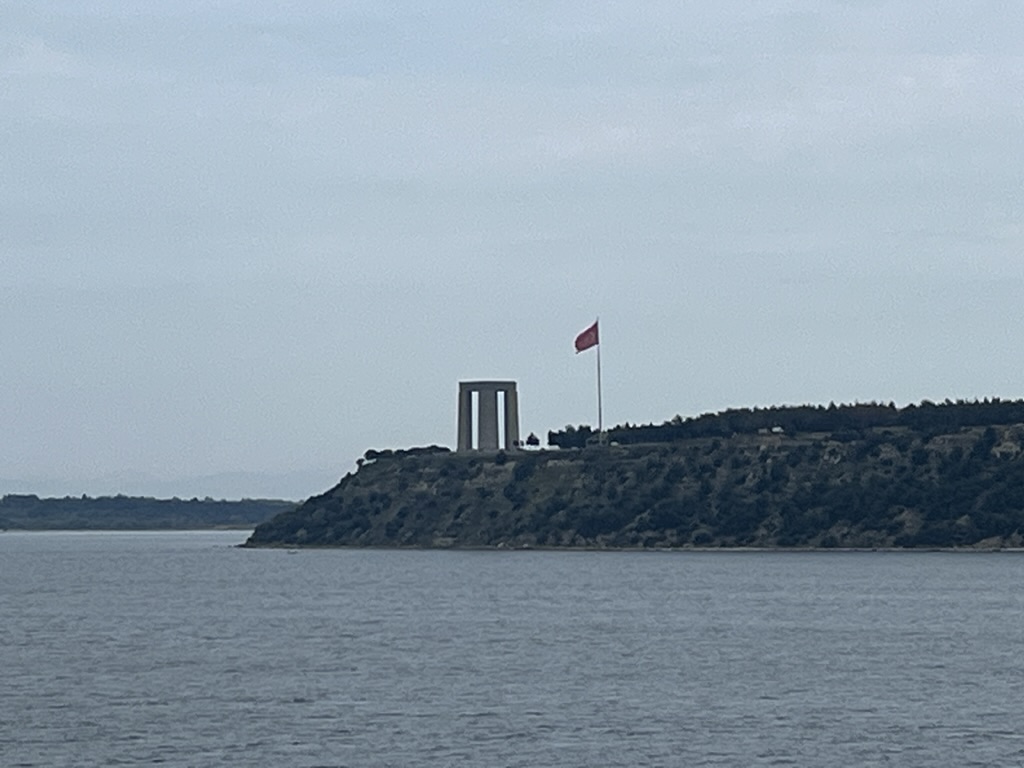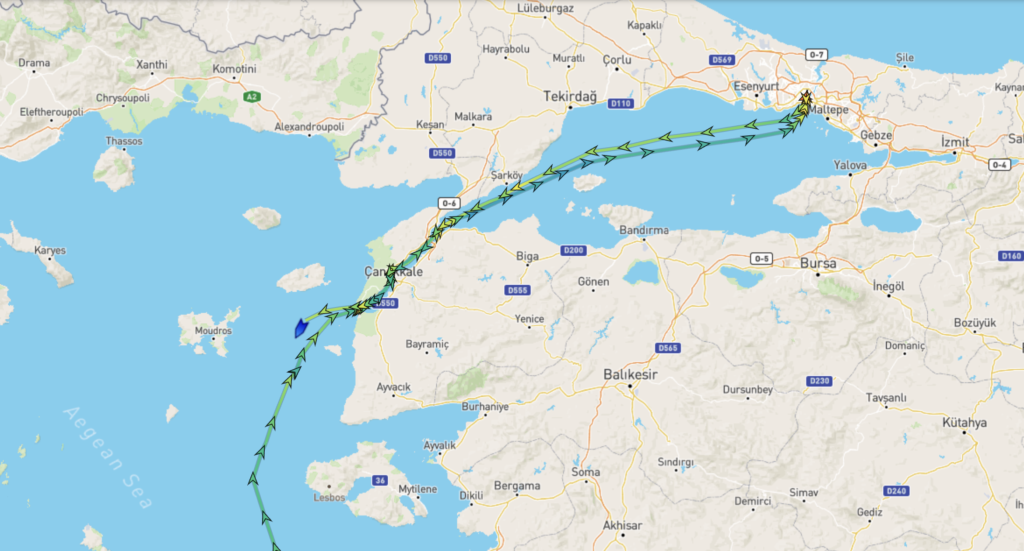
Noon Report:
- Location: N 39° 53.35′, E 025° 48.02′
- Speed: 10.9 knots
- Course: 208º
- Weather: Partly Cloudy
- Temperature: 10º C; 50º F
- Wind: WNW 3 knots; 4 mph
- Sea: Calm
I managed to rouse myself from sleep long enough to see Cheryl leaving to exercise, then dozed off again – waking sometime later to find her quietly engaged in her morning bathroom routine. But I’m feeling some better this morning. I still sound a bit like a pirate, though.
By the time she was done and I was thru my routine it was too late to breakfast and make the 9:30 lecture on Gallipoli, so we headed upstairs for waffles (you saw that coming, right?) and to watch the actual Gallipoli peninsula pass by on our starboard side as we retraced our path back out thru the Dardanelles.
Along the way we photographed several remembrances of the WW I battle that took place here.
Here is the background of the figure on the hill:
Further away, across the straits and also easily visible from the ferry, is the other great ancient fort guarding the Narrows – Kilitbahir (Lock of the Sea). Above the fort, and on a hilltop to the right, is a huge figure of a 1915 Turkish soldier carved in white upon the hillside. In one hand he holds a rifle while his other arm is outstretched towards a Turkish inscription: "Dur yolcu! Bilmeden gelip bastığın Bu toprak, bir devrin battığı yerdir." These words are from a poem by the Turkish poet, Necmettin Halil Onan:
Stop wayfarer! Unbeknownst to you this ground You come and tread on, is where an epoch lies; Bend down and lend your ear, for this silent mound Is the place where the heart of a nation sighs. To the left of this deserted shadeless lane The Anatolian slope now observe you well; For liberty and honour, it is, in pain, Where wounded Mehmet laid down his life and fell. This very mound, when violently shook the land, When the last bit of earth passed from hand to hand, And when Mehmet drowned the enemy in flood, Is the spot where he added his own pure blood. Think, the consecrated blood and flesh and bone That make up this mound, is where a whole nation, After a harsh and pitiless war, alone Tasted the joy of freedom with elation.
This tribute to the 163,000 Turkish troops killed or injured during the campaign is accompanied by the following tribute inscribed on a monument in Canberra Australia dedicated to the 35,000 ANZAC casualties of the campaign. The quote is attributed to Mustafa Kemal Atatürk (Commander of Turkish forces at Gallipoli and first President of the Turkish Republic) :
"Those heroes that shed their blood and lost their lives... you are now lying in the soil of a friendly country. Therefore, rest in peace. There is no difference between the Johnnies and the Mehmets to us where they lie side by side here in this country of ours... You the mothers who sent their sons from far away countries wipe away your tears. Your sons are now lying in our bosom and are in peace. After having lost their lives on this land they have become our sons as well."
We cleared the Dardanelles and entered the Aegean Sea just before 10:30, so I was able to swing by the room, pick up the music, and make it to Quartet practice. That started out pretty rough, but by the end my voice had returned to more or less normal (ie, I could sing two notes without inducing a coughing fit.).
Back in the room we watched the lecture on Barbarossa (the Muslim privateer, not “Barbosa” – the captain in Pirates of the Caribbean, or “Barbarella” – Jane Fonda in a 1968 action comedy space adventure film).
Shortly after the noon announcement we headed up to the Explorer’s Lounge for the noon trivia contest. It was “riddle day” We did OK, but nowhere near as good as we did before he started reading the answers. (Q: What breaks but doesn’t fall, and falls but doesn’t break? A: Daybreak and Nightfall)
Lunch today was a special “Sandwiches and Crisps” event (crisps look a whole lot like potato chips). Cheryl had a cute little salmon sandwich with salad and I had soup – which gave me a pass to have ice cream for dessert.
After lunch Cheryl retired to the pool deck where the roof was closed creating a nice warm space to lounge and read while I came back to the room to work on blog posts a bit.
I woke up as Cheryl returned to the room.
We spent the rest of the day working on blog stuff. (This is the part of the voyage where we’ll spend every spare minute trying to keep blogs up to date since we have an upcoming run of 4 ports within 4 days, and 7 ports in the next 9 days.)
Along the way we missed the 4:30 “Parthenon Marbles: Culture and Controversy” discussion – We probably won’t watch that one later as we already know about it.
We did, however, make it to the 6:30 “Merchant Maritime Republics” – an interesting overview of the maritime history of Amalfi, Pisa, Genoa, Venice, and Dubrovnik – the five major European republics controlling maritime trade from the 10th century up until as late as the 19th century. They were unique in that they weren’t the usual monarch, autocrat, or theocracy led cities, but were maritime trade cities self-governed by the wealthy for the increase of wealth.
After dinner it was BBB where we barely eked out a 50%.
I’m feeling a bit better – almost have my voice back, but we hit the sack early anyway.
So that’s the day.
Not much activity, but a bit of catching up.
Nite all,
R
Cheryl’s Factoids:
- GALLIPOLI CAMPAIGN: 1915-1916 (10 months, 3 weeks, 2 days) This was a gamble that failed. During the stalemate on the WWI Western Front, Britain, France, and the Russian Empire sought to weaken the Ottoman Empire by taking control of the Turkish Straits (access to the Black Sea from the Mediterranean by going up through the Dardanelles Strait, into the Sea of Marmara, and out through the Bosphorus Strait) . This would expose the Ottoman capital of Istanbul to bombardment by Allied battleships and cut it off from the Asian part of the empire. With Turkey defeated, it would force German’s ally, Turkey, out of the war – the Suez Canal would be safe and a year-round Allied supply route could be opened through the Black Sea to warm-water ports in Russia. It began as a naval campaign, with British battleships sent to attack Constantinople but this failed when the Allied warships were unable to force a way through all the mine fields laid in the Dardanelles Strait. Amphibious land attacks were then disasterly defeated. More and more allied soldiers were called up, including those from India – then Australia and New Zealand (the ANZAC legend was born on 25 April 1915, when some 16,000 soldiers of the Australian and New Zealand Army Corps landed under fire on the shores of Gallipoli – still remembered each year with ceremonies). Ironically, the most successful operation of the campaign was the evacuation of the troops on December 19th-20th under cover of a deception operation (“Drip” rifles were self-firing rifles used to deceive the Turks as action appeared to still come from the abandoned trenches). As Britain’s First Lord of the Admiralty, Winston Churchill, masterminded the Gallipoli campaign and served as its chief public advocate, it was no surprise that he ultimately took much of the blame for its failure. As Churchill learned, it was sometimes better to cut one’s losses than to massively to increase the stakes (sounds like Vietnam).
- TROY: as we sailed back down the Dardanelles, we passed close to Hisarlik, which is the currant name for the site that includes the archeological remains of Troy. It is around 19 miles from Canakkale and around 4 miles from the Aegean Sea as well as the Dardanelles. It is best known as the setting for the Greek myth of the Trojan War (archeologists believe a war happened but the wooden horse did not). Troy was repeatedly destroyed and rebuilt during its 4000 years of occupation. As a result, the site is divided into nine archaeological layers, each city being built on the ruins of the previous city.
- Aeneas, a Trojan who escaped the destruction of the city, went to Carthage (Queen Dido fell in love with him and killed herself when he left) then eventually settled in Italy. Aeneas was supposedly the son of Aphrodite (a goddess) and Anchises (who was the great-grandson of Tros, the founder of Troy, and therefore of the royal house-what a lineage)! He was said to be the founder of the Roman race (mixed offspring of the native Italians/Etruscans and the Trojans). His son founded a city called Alba Longa (a nearby settlement that had strong connections with early Rome), and it was there that Romulus and Remus were born many generations later.
